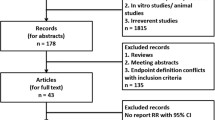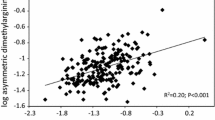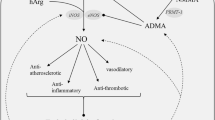Abstract
Background
Asymmetric dimethylarginine (ADMA) is an endogenous nitric oxide synthase inhibitor, which has been associated with total and cardiovascular mortality in various clinical settings. Studies on its structural isomer, symmetric dimethylarginine (SDMA), are scarce. This study aimed to determine the associations of both ADMA and SDMA levels with secondary cardiovascular disease events and all-cause mortality in patients with stable coronary heart disease (CHD).
Methods
In the observational prospective cohort study KAROLA, 1,148 CHD patients were followed for a median of 8.1 years. ADMA and SDMA were determined by liquid chromatography–tandem mass spectrometry. Baseline ADMA and SDMA levels were categorized in quartiles or standardized by their respective standard deviation, and appropriate hazard ratios and 95 % confidence intervals (HR [95 % CI]) were estimated in Cox proportional hazards models.
Results
150 patients experienced secondary cardiovascular disease events (CVD) and 121 patients died. After adjustment for confounders, ADMA was not associated with the risk of secondary CVD events (HR per standard deviation increase: 1.02 [95 %CI: 0.86–1.21]), whereas an association was suggested for SDMA (HR 1.17 [1.00–1.37]). Higher hazard ratios were observed in all-cause mortality models (ADMA: HR 1.15 [0.95–1.37]; SDMA: HR 1.29 [1.09–1.52]).
Conclusions
Our results suggest that especially SDMA might possibly have potential as a risk marker for all-cause mortality and to a lesser extent for secondary cardiovascular events. Future studies are needed to quantify these associations more precisely and should, in particular, further address the possibility of residual confounding by impaired kidney function.


Similar content being viewed by others
References
Boger RH, Zoccali C (2003) ADMA: a novel risk factor that explains excess cardiovascular event rate in patients with end-stage renal disease. Atheroscler Suppl 4:23–28
Ogawa T, Kimoto M, Sasaoka K (1987) Occurrence of a new enzyme catalyzing the direct conversion of NG, NG-dimethyl-l-arginine to l-citrulline in rats. Biochem Biophys Res Commun 148:671–677
Vallance P, Leone A, Calver A, Collier J, Moncada S (1992) Accumulation of an endogenous inhibitor of nitric oxide synthesis in chronic renal failure. Lancet 339:572–575
Boger RH (2007) The pharmacodynamics of l-arginine. J Nutr 137:1650S–1655S
Morris SM Jr (2007) Arginine metabolism: boundaries of our knowledge. J Nutr 137:1602S–1609S
Vallance P, Leone A, Calver A, Collier J, Moncada S (1992) Endogenous dimethylarginine as an inhibitor of nitric oxide synthesis. J Cardiovasc Pharmacol 20(Suppl 12):S60–S62
Boger RH, Bode-Boger SM, Szuba A, Tsao PS, Chan JR, Tangphao O et al (1998) Asymmetric dimethylarginine (ADMA): a novel risk factor for endothelial dysfunction: its role in hypercholesterolemia. Circulation 98:1842–1847
Boger RH, Maas R, Schulze F, Schwedhelm E (2005) Elevated levels of asymmetric dimethylarginine (ADMA) as a marker of cardiovascular disease and mortality. Clin Chem Lab Med 43:1124–1129
Kielstein JT, Donnerstag F, Gasper S, Menne J, Kielstein A, Martens-Lobenhoffer J et al (2006) ADMA increases arterial stiffness and decreases cerebral blood flow in humans. Stroke 37:2024–2029
Maas R, Xanthakis V, Polak JF, Schwedhelm E, Sullivan LM, Benndorf R et al (2009) Association of the endogenous nitric oxide synthase inhibitor ADMA with carotid artery intimal media thickness in the Framingham Heart Study offspring cohort. Stroke 40:2715–2719
Zoccali C, Benedetto FA, Maas R, Mallamaci F, Tripepi G, Malatino LS et al (2002) Asymmetric dimethylarginine, C-reactive protein, and carotid intima-media thickness in end-stage renal disease. J Am Soc Nephrol 13:490–496
Boger RH, Sullivan LM, Schwedhelm E, Wang TJ, Maas R, Benjamin EJ et al (2009) Plasma asymmetric dimethylarginine and incidence of cardiovascular disease and death in the community. Circulation 119:1592–1600
Schnabel R, Blankenberg S, Lubos E, Lackner KJ, Rupprecht HJ, Espinola-Klein C et al (2005) Asymmetric dimethylarginine and the risk of cardiovascular events and death in patients with coronary artery disease: results from the AtheroGene Study. Circ Res 97:e53–e59
Schulze F, Lenzen H, Hanefeld C, Bartling A, Osterziel KJ, Goudeva L et al (2006) Asymmetric dimethylarginine is an independent risk factor for coronary heart disease: results from the multicenter Coronary Artery Risk Determination investigating the Influence of ADMA Concentration (CARDIAC) study. Am Heart J 152:493e1–493e8
Zoccali C, Bode-Boger S, Mallamaci F, Benedetto F, Tripepi G, Malatino L et al (2001) Plasma concentration of asymmetrical dimethylarginine and mortality in patients with end-stage renal disease: a prospective study. Lancet 358:2113–2117
Bode-Boger SM, Scalera F, Kielstein JT, Martens-Lobenhoffer J, Breithardt G, Fobker M et al (2006) Symmetrical dimethylarginine: a new combined parameter for renal function and extent of coronary artery disease. J Am Soc Nephrol 17:1128–1134
Closs EI, Basha FZ, Habermeier A, Forstermann U (1997) Interference of l-arginine analogues with l-arginine transport mediated by the y+ carrier hCAT-2B. Nitric Oxide 1:65–73
Kielstein JT, Fliser D, Veldink H (2009) Asymmetric dimethylarginine and symmetric dimethylarginine: axis of evil or useful alliance? Semin Dial 22:346–350
Aucella F, Maas R, Vigilante M, Tripepi G, Schwedhelm E, Margaglione M et al (2009) Methylarginines and mortality in patients with end stage renal disease: a prospective cohort study. Atherosclerosis 207:541–545
Schulze F, Carter AM, Schwedhelm E, Ajjan R, Maas R, von Holten RA et al (2010) Symmetric dimethylarginine predicts all-cause mortality following ischemic stroke. Atherosclerosis 208:518–523
Wang Z, Tang WH, Cho L, Brennan DM, Hazen SL (2009) Targeted metabolomic evaluation of arginine methylation and cardiovascular risks: potential mechanisms beyond nitric oxide synthase inhibition. Arterioscler Thromb Vasc Biol 29:1383–1391
Meinitzer A, Kielstein JT, Pilz S, Drechsler C, Ritz E, Boehm BO et al (2011) Symmetrical and asymmetrical dimethylarginine as predictors for mortality in patients referred for coronary angiography: the Ludwigshafen Risk and Cardiovascular Health study. Clin Chem 57:112–121
Lloyd-Jones D, Adams RJ, Brown TM, Carnethon M, Dai S, De Simone G et al (2010) Executive summary: heart disease and stroke statistics–2010 update: a report from the American Heart Association. Circulation 121:948–954
Koenig W, Twardella D, Brenner H, Rothenbacher D (2006) Lipoprotein-associated phospholipase A2 predicts future cardiovascular events in patients with coronary heart disease independently of traditional risk factors, markers of inflammation, renal function, and hemodynamic stress. Arterioscler Thromb Vasc Biol 26:1586–1593
Rothenbacher D, Koenig W, Brenner H (2006) Comparison of N-terminal pro-B-natriuretic peptide, C-reactive protein, and creatinine clearance for prognosis in patients with known coronary heart disease. Arch Intern Med 166:2455–2460
Schwedhelm E, Maas R, Tan-Andresen J, Schulze F, Riederer U, Boger RH (2007) High-throughput liquid chromatographic–tandem mass spectrometric determination of arginine and dimethylated arginine derivatives in human and mouse plasma. J Chromatogr B Analyt Technol Biomed Life Sci 851:211–219
Schwedhelm E, Tan-Andresen J, Maas R, Riederer U, Schulze F, Boger RH (2005) Liquid chromatography–tandem mass spectrometry method for the analysis of asymmetric dimethylarginine in human plasma. Clin Chem 51:1268–1271
Levey AS, Stevens LA, Schmid CH, Zhang YL, Castro AF 3rd, Feldman HI et al (2009) A new equation to estimate glomerular filtration rate. Ann Intern Med 150:604–612
Desquilbet L, Mariotti F (2010) Dose–response analyses using restricted cubic spline functions in public health research. Stat Med 29:1037–1057
Beauvieux MC, Le Moigne F, Lasseur C, Raffaitin C, Perlemoine C, Barthe N et al (2007) New predictive equations improve monitoring of kidney function in patients with diabetes. Diabetes Care 30:1988–1994
Soares AA, Eyff TF, Campani RB, Ritter L, Camargo JL, Silveiro SP (2009) Glomerular filtration rate measurement and prediction equations. Clin Chem Lab Med 47:1023–1032
Sun T, Zhou WB, Luo XP, Tang YL, Shi HM (2009) Oral l-arginine supplementation in acute myocardial infarction therapy: a meta-analysis of randomized controlled trials. Clin Cardiol 32:649–652
Zhang QL, Brenner H, Koenig W, Rothenbacher D (2010) Prognostic value of chronic kidney disease in patients with coronary heart disease: role of estimating equations. Atherosclerosis 211:342–347
Jacobi J, Maas R, Cardounel AJ, Arend M, Pope AJ, Cordasic N et al (2010) Dimethylarginine dimethylaminohydrolase overexpression ameliorates atherosclerosis in apolipoprotein E-deficient mice by lowering asymmetric dimethylarginine. Am J Pathol 176:2559–2570
Acknowledgments
The authors wish to thank the participating patients and doctors. Our special thanks go out to Claudia El Idrissi-Lamghari, Data Manager of the KAROLA study, Mariola Kastner and Anna Steenpaß for the technical assistance with the ADMA measurements and Prof. Dr. F. M. Helmerhorst for the sparkling discussions on the subject. Funding: The work reflected in this article was in part funded by the German Ministry of Education and Research (Grant 01GD9820/0), the Association of German Pension Fund Agencies (Grant 02708), Willy-Robert-Pitzer Foundation, the Leducq Foundation, Paris, France for the development of Transatlantic Networks of Excellence in Cardiovascular Research (grant 04 CVD 02) and the Erasmus Life Learning Programme.
Conflict of interest
Renke Maas, Edzard Schwedhelm, and Rainer Böger are co-inventors of a method to determine methylarginines. All other authors have no conflicts to report.
Author information
Authors and Affiliations
Corresponding author
Additional information
Bob Siegerink and Renke Maas contributed equally to this manuscript.
Rights and permissions
About this article
Cite this article
Siegerink, B., Maas, R., Vossen, C.Y. et al. Asymmetric and symmetric dimethylarginine and risk of secondary cardiovascular disease events and mortality in patients with stable coronary heart disease: the KAROLA follow-up study. Clin Res Cardiol 102, 193–202 (2013). https://doi.org/10.1007/s00392-012-0515-4
Received:
Accepted:
Published:
Issue Date:
DOI: https://doi.org/10.1007/s00392-012-0515-4




